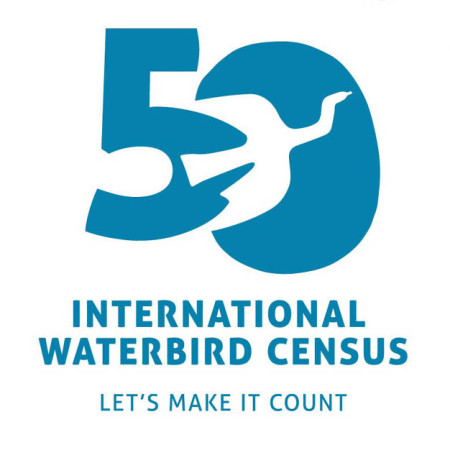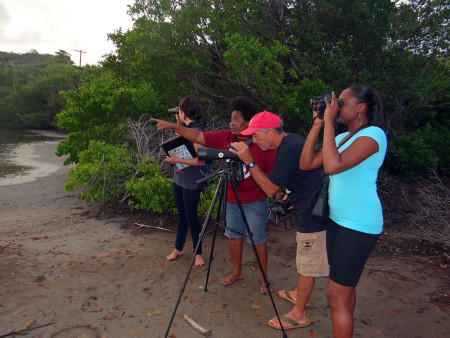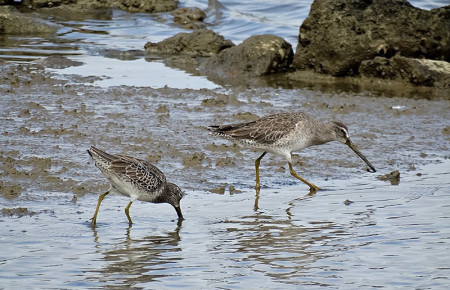
In 1967, while the Vietnam War was being fought, Gilbraltar was deciding if it should remain a British Territory or change over to Spanish ownership, and the first edition of Rolling Stone magazine was published in the U.S. Another history-making event also took place that year—the first International Waterbird Census (IWC). The first count took place in the UK in January of 1967 and included just waterfowl (ducks, geese and swans). Since then the count has grown to include 143 countries across the globe with counters recording numbers of all waterbirds at thousands of sites. This year we celebrate the 50th Anniversary of the IWC, with the theme, “Let’s Make it Count!”
Wetlands International, the coordinator of the IWC has launched a year-long campaign in partnership with governments, non-profit organizations and citizen scientist volunteers to celebrate the 50th Anniversary. They aim to make 2016 the biggest count ever, increasing the number of important wetlands sites covered by the count, to ensure the latest and most up-to-date information about waterbirds is available to support conservation action for waterbirds and wetlands worldwide.
International Waterbird Census – Its Far-reaching Effects
Because of the work of the IWC, over 5 million km2 of critical areas for waterbirds were identified, including Ramsar Sites, World Heritage Sites and network sites in all flyways, and Important Bird Areas. Countries have also come to understand the importance of wetlands, their resources and wildlife. Take for example the case of the Senegal Delta. The wetlands found there are an important home for waterbirds and provide a “rest-stop” for migrants. These wetlands were significantly altered from the construction of dams and the expansion of the agricultural sector. Because of local monitoring of waterbirds, however, more attention was placed on proper management of the wetlands, including re-wetting drained ones, to benefit both wildlife and humans.
In addition to conserving sites and raising awareness, other noble strides and contributions from the IWC include enhanced understanding of relations between wild birds and avian viruses, providing updated information to assist with periodic updates of the IUCN Red List of Threatened Species around the world, and promote informed management of wetlands and waterbirds.

A Closer Look at Home – The Caribbean Waterbird Census (CWC)
Seven years ago, the Caribbean islands, under the auspices of BirdsCaribbean, formally began to contribute to the IWC; and the Caribbean Waterbird Census, or CWC, was born. Every year since 2010, wetlands across the Caribbean region have been visited by enthusiastic, adventure-seeking volunteers eager to observe and count waterbird populations, despite the drawbacks of muddy shoes and encounters with hungry sandflies and mosquitoes. The regional CWC is a three-week count that begins on 14th January and ends on 3rd February. Partners are encouraged to carry out counts at all times of the year, however, especially during the spring and fall migration periods.
For the past two years, the Caribbean has suffered from a cataclysmic drought, which has obviously affected many of our wetlands. Notwithstanding, for this seventh consecutive year, the teams across the region have gone out and done their counts. On Union Island, St. Vincent and the Grenadines, Orisha Joseph and her team of 10 have made sure that populations of waterbirds at Ashton Lagoon and Belmont Salt Pond have been accounted for. In Antigua, top counting spots, though surveyed, yielded little results as in the case of Potworks Dam and Bethesda Dam, which have been bone dry for months. However, Andrea Otto and her team have gotten promising numbers having covered Christian Cove, Pelican Island Pond, Valley Church Pond, Jabberwock Swamp and McKinnon’s Pond.
This year, the International Piping Plover Census, conducted every 5 years, was done simultaneously with the CWC. The Caribbean provides important wintering grounds for these daring flyers among other shorebirds including Ruddy Turnstones, Black-necked Stilts, Greater and Lesser Yellowlegs, and Willets. Thanks to the CWC, we are able to understand if their populations are in decline, stable or are increasing.

If you are in the Caribbean and interested in participating in the CWC, learn how to do so here. Also, don’t forget to upload your sightings to eBirdCaribbean. Keep counting, keep recording, and keep taking photos! The CWC helps us understand the distribution, status and abundance of waterbirds on a local, regional and global level, thus helping us, like the IWC, to make informed decisions on their conservation and management. From the CWC, we are learning which sites are important for supporting huge populations of waterbirds, as well as the key wintering and migration stopover sites for threatened and declining species such as the Red Knot, Whimbrel, Reddish Egret, American Oystercatcher, and Semipalmated Sandpiper.
Over 240 sites are currently monitored by volunteer counters in our network. However, with over 7,000 islands and islets in the Caribbean, many important sites have not yet been included. We invite you to be a part of the biggest count ever. Remember, we have 11 more months to plan and execute a great count for the CWC and IWC!
